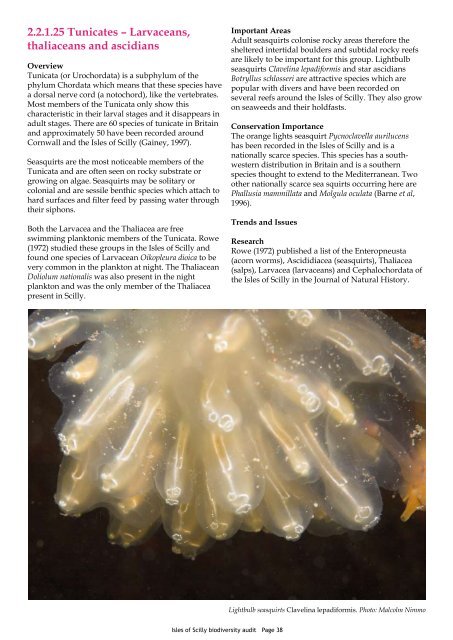The Isles of Scilly Biodiversity Audit 2008 - Cornwall Wildlife Trust
The Isles of Scilly Biodiversity Audit 2008 - Cornwall Wildlife Trust
The Isles of Scilly Biodiversity Audit 2008 - Cornwall Wildlife Trust
Create successful ePaper yourself
Turn your PDF publications into a flip-book with our unique Google optimized e-Paper software.
2.2.1.25 Tunicates – Larvaceans,thaliaceans and ascidiansOverviewTunicata (or Urochordata) is a subphylum <strong>of</strong> thephylum Chordata which means that these species havea dorsal nerve cord (a notochord), like the vertebrates.Most members <strong>of</strong> the Tunicata only show thischaracteristic in their larval stages and it disappears inadult stages. <strong>The</strong>re are 60 species <strong>of</strong> tunicate in Britainand approximately 50 have been recorded around<strong>Cornwall</strong> and the <strong>Isles</strong> <strong>of</strong> <strong>Scilly</strong> (Gainey, 1997).Seasquirts are the most noticeable members <strong>of</strong> theTunicata and are <strong>of</strong>ten seen on rocky substrate orgrowing on algae. Seasquirts may be solitary orcolonial and are sessile benthic species which attach tohard surfaces and filter feed by passing water throughtheir siphons.Both the Larvacea and the Thaliacea are freeswimming planktonic members <strong>of</strong> the Tunicata. Rowe(1972) studied these groups in the <strong>Isles</strong> <strong>of</strong> <strong>Scilly</strong> andfound one species <strong>of</strong> Larvacean Oikopleura dioica to bevery common in the plankton at night. <strong>The</strong> ThaliaceanDoliolum nationalis was also present in the nightplankton and was the only member <strong>of</strong> the Thaliaceapresent in <strong>Scilly</strong>.Important AreasAdult seasquirts colonise rocky areas therefore thesheltered intertidal boulders and subtidal rocky reefsare likely to be important for this group. Lightbulbseasquirts Clavelina lepadiformis and star ascidiansBotryllus schlosseri are attractive species which arepopular with divers and have been recorded onseveral reefs around the <strong>Isles</strong> <strong>of</strong> <strong>Scilly</strong>. <strong>The</strong>y also growon seaweeds and their holdfasts.Conservation Importance<strong>The</strong> orange lights seasquirt Pycnoclavella aurilucenshas been recorded in the <strong>Isles</strong> <strong>of</strong> <strong>Scilly</strong> and is anationally scarce species. This species has a southwesterndistribution in Britain and is a southernspecies thought to extend to the Mediterranean. Twoother nationally scarce sea squirts occurring here arePhallusia mammillata and Molgula oculata (Barne et al,1996).Trends and IssuesResearchRowe (1972) published a list <strong>of</strong> the Enteropneusta(acorn worms), Ascididiacea (seasquirts), Thaliacea(salps), Larvacea (larvaceans) and Cephalochordata <strong>of</strong>the <strong>Isles</strong> <strong>of</strong> <strong>Scilly</strong> in the Journal <strong>of</strong> Natural History.Lightbulb seasquirts Clavelina lepadiformis. Photo: Malcolm Nimmo<strong>Isles</strong> <strong>of</strong> <strong>Scilly</strong> biodiversity audit Page 38
















